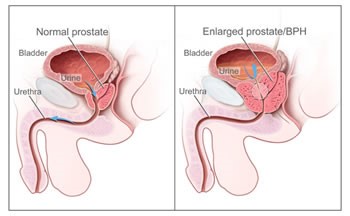BPH
The term Benign Prostatic Hyperplasia (BPH) relates to an enlarged prostate which is not cancerous, but which may cause bothersome problems with the waterworks or lower urinary tract symptoms (LUTS) thanks to the resultant obstruction to the flow of urine out of the bladder. It is a very common problem in men, the growth in the prostate probably starting in middle age. It may result in bothersome symptoms in approximately 50 percent of men between the ages of 51 and 60 and up to 90 percent of men over the age of 80.

Typical symptoms for BPH include;
- Difficulty in passing water,
- Having to go to the toilet frequently or urgently,
- Having to get up several times during the night,
- Dribbling at the end of urinary flow and sometimes incontinence.
The symptoms can impact on quality of life causing embarrassment, tiredness and limitations to the activities one can undertake. Furthermore, it may also result in the sudden and often painful inability to pass urine (acute urinary retention) leading to emergency hospital attendance and the siting of a drainage tube down the water pipe (urethra) into the bladder (a catheter). It is worth noting that this is a much more common disease than prostate cancer which is often symptom free in its early stages.
This video below explains Benign Prostate Enlargement, the symptoms and treatments available.
The following two videos were funded by the NHS and Neil Barber was involved with the production team at Health Innovation Oxford and Thames Valley (formerly Oxford AHSN), to input clinical knowledge and advice.
In 2018, the NHS set up the GIRFT Academy initiative - Getting it Right First Time. A report on Urology pathways found many variations. A team of specialists and researchers, including Richard Hindley and Neil Barber have produced the attached guide to improving the management of Bladder Outlet Obstruction. There is a very useful diagram showing an outline of the ideal pathways to follow and the use of MIST - Minimally Invasive Surgical Treatment options for patients.
You can read this guide here
Information on treatment for LUTS and BPH can be found in the Treatments section or by clicking the links below.